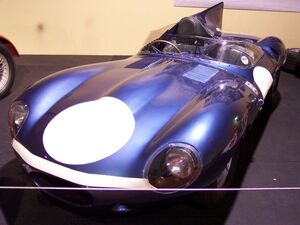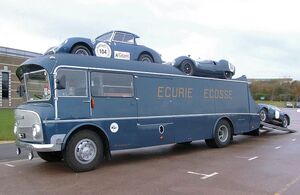| Ecurie Ecosse | |
|---|---|
| {{{Marque}}} | |
| Constructor Name | {{{constructor name}}} |
| Long Name | {{{long name}}} |
| Base | Merchiston, Edinburgh |
| Founder(s) | {{{Founder(s)}}} |
| Noted staff | {{{Noted staff}}} |
| Noted drivers | {{{Noted drivers}}} |
| Previous name | {{{Previous name}}} |
| Next name | {{{Next name}}} |
| First entry | {{{First entry}}} |
| Races entered | {{{Races entered}}} |
| Engines | {{{engines}}} |
| Constrctuors' Championships | {{{Constrctuors' Championships}}} |
| Drivers' Championships | {{{Drivers' Championships}}} |
| Race victories | {{{Race victories}}} |
| Final | {{{final}}} |
| Podiums | {{{Podiums}}} |
| Points | {{{Points}}} |
| Pole positions | {{{Pole positions}}} |
| Fastest Laps | {{{fastest laps}}} |
| Final entry | {{{Final entry}}} |
Ecurie Ecosse (fr.Team Scotland) was a motor racing team from Scotland. The team was founded in 1952 by Edinburgh businessman and racing driver David Murray and mechanic Wilkie Wilkinson, its most notable achievement was winning both the 1956 and 1957 24 Hours of Le Mans. The team also raced in three Formula One races. Ecurie Ecosse's cars were always distinctive in their Flag Blue Metallic paint.
Formula One[]
Ecurie Ecosse had four Formula One Grand Prix entries, over three seasons. The first was by David Murray himself, driving a Cooper T20 in the 1952 British Grand Prix. However, he retired with engine trouble early in the race.
For the 1953 event the team entered two cars a Cooper T20 for Jimmy Stewart a new Connaught A Type was entered for Ian Stewart. Unfortunately neither of the drivers finished the race; Jimmy spun off track on lap 79, and Ian retired with engine problems.
The team's last F1 outing was at the 1954 British Grand Prix, where the Connaught was again entered, this time driven by Leslie Thorne. Although this time the car did take the finish, it came in twelve laps down on the leaders. From this point onward the team concentrated on sportcar events.
Complete Formula One World Championship results[]
(key) (results in bold indicate pole position; results in italics indicate fastest lap)
| Year | Chassis | Engine | Tyres | Driver | 1 | 2 | 3 | 4 | 5 | 6 | 7 | 8 | 9 |
|---|---|---|---|---|---|---|---|---|---|---|---|---|---|
| 1952 | Cooper T20 | Bristol BS1 2.0 L6 | D | SUI | 500 | BEL | FRA | GBR | GER | NED | ITA | ||
| Ret | |||||||||||||
| 1953 | Connaught Type A Cooper T20 |
Lea-Francis 2.0 L4 Bristol BS1 2.0 L6 |
D | ARG | 500 | NED | BEL | FRA | GBR | GER | SUI | ITA | |
| Ret | |||||||||||||
| Ret | |||||||||||||
| 1954 | Connaught Type A | Lea Francis 2.0 L4 | D | ARG | 500 | BEL | FRA | GBR | GER | SUI | ITA | ESP | |
| 14 |
Formula Two[]
Ecurie Ecosse also raced in the European Formula Two Championship, from 1969 until 1971. Their first race was in 1969 at Thruxton where driver Graham Birrell finished 11th in a Brabham BT23C. At Enna Birrell couldn't start the race because he had crashed the car in practice and the team couldn't repair the car before the race. In 1970 Ecurie Ecosse entered the same car for Birrell. At Crystal Palace Birrell finished in 11th position. In the next race held at the Hockenheimring Birrell finished in 12th position. In Imola Richard Attwood took over from Birrell; after finishing sixth in the first heat, he was unable to start the second heat and was therefore not classified. In 1971 Ecurie Ecosse had a new driver; Tom Walkinshaw, they also had a new car: a March 712M. At Thruxton Walkinshaw retired on lap three due to a puncture. At the Nürburgring, Gerry Birrell finished in ninth position. In their last two races, at Jarama and Crystal Palace, Walkinshaw failed to qualify for the race.
Complete European Formula Two results[]
(key) (Results in bold indicate pole position; results in italics indicate fastest lap; † indicates shared drive.)
| Year | Chassis | Engine(s) | Drivers | 1 | 2 | 3 | 4 | 5 | 6 | 7 | 8 | 9 | 10 | 11 |
|---|---|---|---|---|---|---|---|---|---|---|---|---|---|---|
| 1969 | Brabham BT23C | Cosworth FVA | THR | HOC | NÜR | JAR | TUL | PER | VAL | |||||
| 11 | DNS | |||||||||||||
| 1970 | Brabham BT30 | Cosworth FVA | THR | HOC | BAR | PAL | HOC | PER | TUL | IMO | HOC | |||
| 11 | 12 | |||||||||||||
| Ret | ||||||||||||||
| 1971 | March 712M | Cosworth FVA | HOC | THR | NÜR | JAR | PAL | ROU | MAN | TUL | ALB | VAL | VAL | |
| Ret | DNQ | DNQ | ||||||||||||
| 9 |
24 Hours of Le Mans[]

A Jaguar D-Type in the metallic blue with white nose-band livery of Ecurie Ecosse (1956 Le Mans race).
In the 1956 24 Hours of Le Mans Ron Flockhart and Ninian Sanderson were the winning drivers in a Jaguar D-Type.
Ron Flockhart won again with a D-Type in the 1957 event, partnered this time by Ivor Bueb. The team's second D-Type–driven by Sanderson and his new partner John Lawrence–finished second, a rare privateer 1-2 finish.
The 1958 Le Mans race was less successful; both of the Ecurie Ecosse D-Types, this time with Masten Gregory and Jack Fairman added to the driver line-up, suffered engine failure within a few laps of the start.[1]
The team would again field a D-Type at Le Mans in 1959, alongside a newly acquired Tojeiro-Jaguar. Once again, neither car made it to the final flag, the D-Type suffering engine failure after 70 laps, and the Tojeiro a fire after 137.[2]
Things went from bad to worse for the team in the 1960 running. The, by now much modified, D-Type was again entered, and lasted until the 168th lap before being forced out with a broken crankshaft. Ecurie Ecosse's second car for this year, a Cooper T49 Monaco, did not even make it to the start line.[3]
The entrants for the 1961 24 Hours of Le Mans - a Cooper T57 Monaco and an Austin-Healey Sebring Sprite - retired after accidents in their 32nd and 40th laps respectively.[4]
1962 saw Ecurie Ecosse moving on to a Tojeiro EE, but this too failed to finish after gearbox problems. This would be the last time that the original Ecurie Ecosse team would enter a car for the greatest endurance race in the world. Financial troubles and the self-imposed tax exile of founder David Murray had effectively ended the team's competitive era by the mid-1960s.
Drivers[]
The drivers included David Murray himself; Jimmy Stewart; his younger brother, three-time F1 World Champion Jackie Stewart;[5] fellow F1 driver Innes Ireland; and CanAm legend and eventual Le Mans winner Masten Gregory; Ian Stewart; Leslie Thorne; Ron Flockhart; Ninian Sanderson; Roy Salvadori; Ivor Bueb; John Lawrence; Jack Fairman; and John Tojeiro
1980s revival[]
The original team ceased operating in 1971, but the team name was revived in the 1980s by enthusiast and driver Hugh McCaig. In 1986 the team won the C2 class of the World Sportscar Championship; they had been runners-up the previous year. They also entered Vauxhall Cavaliers in the British Touring Car Championship with some success in 1992 and 1993, including a win at Thruxton in 1993 for David Leslie.
2011 revival[]
Team boss Hugh McCaig announced that four young drivers, Alasdair McCaig Andrew Smith Joe Twyman and Oliver Bryant, would revive the team once more and drive a return to sports car racing for the team, 25 years after winning the World Sportscar Championship in 1986 in the C2 class. The team will enter an Aston Martin DBRS9, along with the help of Aston Martin Racing Partner Team Barwell Motorsport, into the 2011 24 Hours of Spa in the GT3 class. They will be racing for outright victory for the 2011 edition of the famous Spa 24 Hours as it is the first time that GT3-spec cars are the top class of car, before it was GT1 (2000–2009) and GT2 (2010). The driver line-up will consist of Alasdair McCaig, Andrew Smith, Joe Twyman and Oliver Bryant.[6]
Team car transporter[]

The restored Ecurie Ecosse Car Transporter
The Team was accompanied by a 2-axle double-deck car transporter capable of carrying three cars (one inside and two on top) together with a support crew, and with mobile workshop facilities.
The transporter was built by coachbuilders Alexander, of Falkirk, Scotland. Based on a Commer chassis it is powered by a Commer TS3 three cylinder horizontally-opposed two-stroke diesel engine.
The transporter has been restored and is still in use.
Models[]
The Le Mans wins captured the public's imagination and British die-cast model manufacturer Corgi brought out a 1/48th scale model in its Corgi Major series, which proved very popular. A number of sets were produced with differing vehicles; for example Gift Set No 16 issued in 1965 included three racing cars in individual boxes; a #151A Lotus X1, a #152S BRM and a #154 Ferrari. Although out of production, the Corgi sets have remained popular among collectors.
Bibliography[]
- Dymock, Eric: Ecurie Ecosse: David Murray and the Legendary Scottish Motor Racing Team (PJ Publishing, 2007, ISBN 978-0-9550102-2-4)
- Gauld, Graham: Ecurie Ecosse: A Social History of Motor Racing from the Fifties to the Nineties (Graham Gauld Public Relations, Edinburgh, 1992, ISBN 0-9519488-0-6)
- Murray, David: Ecurie Ecosse: The Story of Scotland's International Racing Team (Stanley Paul, London, 1962)
References[]
- ↑ "1958 Le Mans 24 Hours". www.teamdan.com. http://www.teamdan.com/archive/wsc/1958/58lemans.html. Retrieved 4 May 2011.
- ↑ "1959 Le Mans 24 Hours". www.teamdan.com. http://www.teamdan.com/archive/wsc/1959/59lemans.html. Retrieved 4 May 2011.
- ↑ "1960 Le Mans 24 Hours". www.teamdan.com. http://www.teamdan.com/archive/wsc/1960/60lemans.html. Retrieved 4 May 2011.
- ↑ "1961 Le Mans 24 Hours". www.teamdan.com. http://www.teamdan.com/archive/wsc/1961/61lemans.html. Retrieved 4 May 2011.
- ↑ "Grand Prix Hall of Fame - Jackie Stewart - Biography". www.ddavid.com. http://www.ddavid.com/formula1/stew_bio.htm. Retrieved 4 May 2011.
- ↑ "Ecurie Ecosse returns with Aston Martin DBRS9". PlanetLeMans. http://www.planetlemans.com/2011/02/28/ecurie-ecosse-returns-with-aston-martin-dbrs9/. Retrieved 4 May 2011.